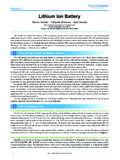Transcription of BUSINESS WHITEPAPER - exergy.energy
1 BUSINESS WHITEPAPERF ebruary 10, 2018 INTRODUCTION TO EXERGY From Brooklyn to Bangladesh, the new energy consumer wants comfort, security, a more engaging relationship, and a promising future for energy production. A democratized energy marketplace is the only way to achieve this promise, and the Exergy project team, part of LO3 Energy, has developed a key piece of this paradigm shift. With Exergy, we are reimagining the customer s role in, and access to, increasingly open and competitive electricity the Electric Power Technical WHITEPAPER , we define transactive energy and why it is linked to the physical concept of exergy, or the portion of energy available for useful work in our economies. That paper defines and describes the value domains and technical attributes required for transactive energy in the multi-party electric power system emerging today.
2 It introduces the idea that we should not consider kWh as the sole attribute of energy service, when equally crucial is where, how and when that kWh was generated for use. As grid edge energy solutions are adopted, the paper describes how a transactive energy marketplace optimizes for lowest cost, lowest carbon, and more resilient networks supported by consumers, new energy service providers and system operators this paper (the Exergy BUSINESS WHITEPAPER ), we link the technical value domains to the services that consumers and third parties can provide to one another and to the electric power system. We propose what Exergy will accomplish and how it can be utilized by energy system participants including third party publications are planned by the Exergy project team to go deeper into country- and local-level regulatory and policy drivers and barriers to delivering transactive energy and Exergy.
3 Likewise, the deeper academic work that builds on the current work of economists to measure and account for exergy rather than energy will happen in parallel to the technical development of the Exergy token Problem .. 5 The Opportunity .. 6 The Time is Now .. 7 The Solution .. 8 Market Size .. 9 Product .. 10 Customizable App .. 11 Information System Distributed Ledger .. 11 Hardware .. 12 Exergy Foundation .. 12 Competition .. 13 Traction .. 14 Use Case 1: Peer-To-Peer .. 14 Use Case 2: Microgrid .. 16 Use Case 3: Distribution System Operator .. 17 Use Case 4: EV smart charging .. 19 Use Case Pipeline .. 19Go to Market Strategies .. 201: Establish partnerships .. 202: Garner network growth .. 203: Incentivize token distribution.
4 21 Token Interactions .. 23 The Revolution .. 27 Scaling to Meet Future Demands .. 28 Team .. 29 Table of Contents5 The ProblemOur economies run on energy, but the current energy system is costly and useful energy is one of the dirtiest and most wasteful things we do, from mining, refining and burning fuel, to transporting electricity across long transmission and distribution lines. In the US, some estimates show an 86 percent inefficiency in converting and transporting energy into the useful product (described by physicists as exergy ) that powers modern lifestyles and economic This creates unintended and costly health and environmental challenges, from asthma to climate change, and a significant loss of economic value.
5 This problem has emerged because in the current power sector BUSINESS models, utilities use outdated constructs of its consumers as rate payers; missing the opportunity and value only a customer can provide. Companies earn revenue based on producing energy at the center of the utility grid, in large power plants, and pushing it to the grid edge where it serves the load as it is consumed. Companies generating and distributing power are accustomed to roughly 10 percent returns on their capital This model locks in profitability for regulated electricity companies, but discourages innovation and saddles consumers with decades of legacy costs. Today, traditional utility businesses can no longer simply rely on demand for the kWh commodity.
6 Policy, regulation, technology and customer expectations are all contributing to a shifting paradigm. Our global commitments to halting climate change, as well as a slew of energy efficiency policies and subsidies for renewable power are bringing in a new wave of technological innovation such as smart energy services, battery storage, and rooftop solar PV, making it possible for us to not only save energy, but to produce our own power in factories and homes alike. In newly-electrifying countries, a centralized grid is too costly and sluggish for the needs of the one billion people without energy access today. As demand grows, it also becomes more is harder and more costly to predict and balance demand and supply while lacking visibility into millions of new consumer devices and distributed energy resources popping up at the grid These trends are tearing apart existing utility BUSINESS models and spooking shareholders and analysts 1 Laitner, Skip.
7 Linking energy efficiency to economic productivity: recommendations for improving the robustness of the economy, WIREs Energy Environ 2015, 4:235 252. See for instance California Public Utilities Commission: (2014_forward) Though examples abound in countries facing higher penetration of renewables, see for instance how PJM market operators push back with even further subsidies that drive up costs for consumers. These trends are outlined in greater detail in our Electric Power 7 OpportunityIn the model of the future, ratepayers become the customers. Utilities will have to serve many, many more customers, from consumers and prosumers to third parties who want to access and sell services to these new customers.
8 Demand for the kWh commodity may be falling,5 but demand for new energy services is on the technology were the only driver, its adoption could be stopped. But this opportunity is not only about technology, it s about the way the technology is adopted by consumers, not by regulated companies. Consumers will continue to buy and use smart phones, smart appliances, and distributed renewable energy, because they think it improves their Our vision is that people, citizens, communities and energy consumers everywhere can show their demand for exergy not wasted energy in our global system by resetting the rules of the marketplace. Today s Market AssumptionsThe New RealityConsumers have no frame of reference for a kWh it is a metric with no intrinsic value, only relative expectations for local or green products, convenience or entire focus is on managing from the center, and the supply problems almost always come from the edge, not the center, making them very hard and expensive to capital costs are repaid by consumers through broad, not specific.
9 Pricing energy generation struggles to compete and recover costs due to ever-cheaper more generation and grid infrastructure is the only way to manage distributed energy smart utilization of the grid reduces costs for customers and increases and location of production and consumption are not fully and location along with other attributes matter a lot and will have significant centralized nodes and limited data and millions of new devices exist at the grid 1 Why the market is changingBy virtue of a technological tsunami we are returning to a more decentralized system, and at the same time turning more and more of the industry over to competitive forces, trading economies of scale and predictability for economies of scope and consumer Anne Pramaggiore, President and CEO of Commonwealth Edison7 The Time is NowToday, 69 percent of consumers are interested in having more options to buy local or differentiated energy The new reality for the energy industry is one in which consumers, commercial and industrial operators all think differently about participating in electric power services, just as they now take other new services for granted, from Amazon s on-demand shopping to Uber s rideshare service.
10 It is a new reality in which electric vehicles displace gasoline demand, combined heat and power (CHP), solar PV, and wind displace coal and nuclear generation, and heat pumps, thermal storage, and batteries begin to reduce the consumption demand for natural gas. The displaced fossil fuel in this new energy reality will be the data that allows this new value to be unlocked. The data is not simply kWh, but accounts for the state of the grid, the time and location of production, and consumption requirements of a multi-party electricity system (see our Electric Power Technical White Paper). Having this data removes friction in buying and selling real value-added energy services. Our energy industry is digitizing, but it s one of the last industries to do so.





